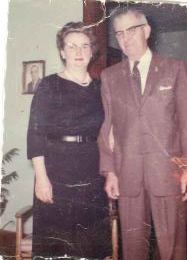Lavender, WW I, and My Grandmother
Cristin McDonnell has studied Ayurvedic medicine and brings her interest in healing to our work here at Harms Vineyards and Lavender Fields. This is one of a series of her blogs on healing.
Moving to California has certainly opened new doors in terms of thinking about my family. It would be impossible to work with lavender and not think about France. Thinking about France and lavender led me to making connections with my grandmother—connections that I would not have made had it not been for my current job.
Julia McDonnellMy grandmother, Julia Decoene McDonnell, was not always the easiest woman to get to know (for reasons that will become obvious soon). She worked very hard, was always up early, bed made, house cleaned and laundry done neatly and efficiently all by noon—all by noon, everyday. She had such a different life from my brothers and me, and without careful reflection on her childhood, it was hard to understand why she and I had such a difficult time connecting. Although she was tough, I do know she adored us. And to be perfectly honest and fair, I was around her the most when I was the ages of twelve to fourteen. I would not want to go back and meet my own thirteen-year old self!
Julia was born in Roeselare, Belgium, in 1911. At the start of World War 1, Roeselare was heavily occupied by the Germans. My grandmother’s parents were forced to send my three year old grandmother to live with relatives as a war refugee in Marseille, France, and she was not reunited with her parents until 1921 in the United States. I always thought of my grandmother as a ‘tough love-type’. I suppose when you have survived a war, a separation from family, and being transported to another country alone on a ship, tough is hardly an accurate description for the kind of strength a child must have to develop and endure such hardship.
The war had what one could consider a silver lining to a very ominous cloud, that silver lining looked at from a position of plants: World War I was also a time of lavender. A timely accident occurred in 1910 when French chemist, René-Maurice Gattefossé burned his hand in a laboratory and treated the burn with lavender. In rinsing his hand with lavender, he noticed that it stopped “the gasification on the tissue.” Many sites note the story of Gattefossé, and how this discovery led to the use of essential oils in military hospitals during WW1. Fatal infections were the cause of many amputations during the war. Lavender and other essential oils were used for their antiseptic properties– a beautiful, medicinal plant bringing healing to injured soldiers during a time of darkness.
Lavender is a hardy, resilient plant that grows in rocky, dry soils. This plant’s growing conditions seem metaphoric to the people of that time. Resilient, yet beautiful in their courage.
My grandmother was living in Marseille during the war, Marseille being one of the areas best known for lavender. She and I have more in common than we were able to realize before she passed away in 1995. We both have a ‘Jack of All Trade’ way about us. She and I also would have connected around the career choices we made. My grandmother was a teacher and a registered nurse. I too was a teacher for twelve years, and have an interest in health care, although my interest is in holistic health care. With these similarities and family history, I can’t help but wonder, were my grandmother alive today, would she and I would find a commonality on the subject of lavender too?

